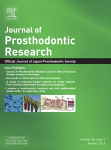Special Edition
59 巻, 3 号
Journal of Prosthodontic Research
選択された号の論文の9件中1~9を表示しています
- |<
- <
- 1
- >
- >|
Editorial
-
2015 年59 巻3 号 p. 159-160
発行日: 2015/07/25
公開日: 2015/12/23
PDF形式でダウンロード (578K)
Review
-
2015 年59 巻3 号 p. 161-171
発行日: 2015/07/25
公開日: 2015/12/23
PDF形式でダウンロード (2402K)
Original Articles
-
2015 年59 巻3 号 p. 172-177
発行日: 2015/07/25
公開日: 2015/12/23
PDF形式でダウンロード (710K) -
2015 年59 巻3 号 p. 178-184
発行日: 2015/07/25
公開日: 2015/12/23
PDF形式でダウンロード (699K) -
2015 年59 巻3 号 p. 185-193
発行日: 2015/07/25
公開日: 2015/12/23
PDF形式でダウンロード (1678K) -
2015 年59 巻3 号 p. 194-198
発行日: 2015/07/25
公開日: 2015/12/23
PDF形式でダウンロード (728K)
Case Report
-
2015 年59 巻3 号 p. 199-204
発行日: 2015/07/25
公開日: 2015/12/23
PDF形式でダウンロード (1932K) -
2015 年59 巻3 号 p. 205-209
発行日: 2015/07/25
公開日: 2015/12/23
PDF形式でダウンロード (2105K)
Letter to the Editor
-
2015 年59 巻3 号 p. 210-212
発行日: 2015/07/25
公開日: 2015/12/23
PDF形式でダウンロード (1828K)
- |<
- <
- 1
- >
- >|
